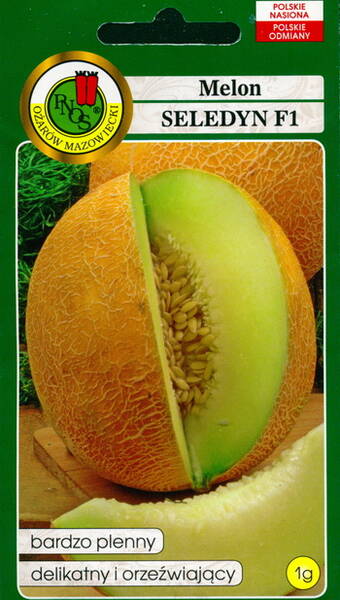An early-ripening variety for open ground. The plant is medium-vine. The fruits are spherical, yellow-orange, and weigh up to 1.2 kg. The flesh is yellowish-green, with a strong melon aroma, melting, and high in sugars and carotene. The variety is resistant to adverse weather conditions.
Agricultural technology.
Melons are grown by sowing directly into the ground in May or by seedlings. Sow melons in mid-March in peat pots.
The optimal temperature from sowing to emergence is +25 to +30°C, after emergence: +15 to +17°C. Seedlings are pinched above the 5th leaf to form lateral shoots.
Seedlings are planted in the ground after the last spring frosts. Water and fertilize the holes and around the seedlings, avoiding wetting the leaves and root collars.
To speed up the process of seed germination, improve plant health, and fruit set, it is recommended to use specially developed plant growth and development stimulants (for example: Epin or Zircon ).
1.0 g = 12-25 seeds.
The supply of nutrients in sprouted seedlings is very limited.
For intensive growth, organic matter is needed, but plants receive only mineral substances from the soil, while plants must produce organic matter through photosynthesis.
In bright light, developing leaves undergo active photosynthesis, producing 10 times more organic matter than is burned during respiration. Under these conditions, seedlings of most crops are ready for transplanting within 1-1.5 weeks after emergence.
In the dim light of a cloudy February day, photosynthesis is so low that most of the organic matter produced is burned through respiration. Therefore, seedlings slowly build up biomass. Not receiving enough light, the sprouts stretch, using up the remaining nutrients stored in the seed. Such seedlings often suffer from root rot and blackleg.
What level of illumination can be considered sufficient when growing seedlings?
Seedlings grow well under 8,000 lux of light. For the first 2-3 days, seedlings require 24-hour light, and then 15-16 hours of light in the following days.
What kind of illumination do we have on the windowsill?
At best, 2500-3000 lux (March 1st in Estonia, on a south-facing window on a clear day). Daylight hours on March 1st are only 10 hours and 40 minutes long, while on April 1st, it's about 13 hours. This means there's very little light on the windowsill for vegetable seedlings, so supplemental lighting is needed.












